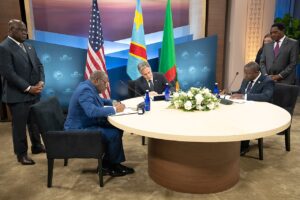
Background
During the course of 2019-20201July 9, 2019; February 13, 2020; May 26, 2020, the Stimson Center and the Observer Research Foundation convened multiple conversations between Indian and American analysts to explore various aspects of the U.S.-India relationship, including strategic priorities, points of tension, and opportunities for greater collaboration between the two countries. The groups capped these conversations with a structured dialogue on September 3, 2020 focused on four topics: Indian defense capabilities, Russia, Southeast Asia, and the future trajectory of the U.S.-India strategic relationship. Each will feature prominently as issues the next U.S. administration and current Indian government will need to consider as both partners navigate the future of the Indo-Pacific strategy.
I. Indian Defense Capabilities
The discussion on defense focused on two areas: U.S.-India defense technology cooperation and changes underway in the Indian national security system. No significant shift is expected in the near- to medium-term.
- Defense Technology. Both sides agreed that the U.S.-India Defense Technology and Trade Initiative (DTTI) has underperformed its goals. Indian interlocutors suggested that, traditionally, the United States has viewed DTTI as a way to sell hardware by bypassing India’s cumbersome defense acquisition process, whereas India views DTTI as a way to access privileged U.S. technology. This mismatch in expectations has hamstrung collaboration. American interlocutors suggested that the focus of DTTI should move away from big-ticket items to co-development of smaller platforms and nascent technologies where both sides genuinely seek collaboration. This can build India’s indigenous defense technology ecosystem and absorptive capacity, though more slowly than India would like. This has already begun, with reports of cooperation on air-launched swarming drones.
- An increase in private sector involvement and introduction of higher thresholds for FDI are two recent changes in the Indian defense industry that could reinvigorate U.S.-India defense cooperation. Even if defense sales slow, American participants suggested, the United States and India could concentrate on greater maritime collaboration and intelligence sharing.
- Defense Reforms, Priorities. Indian participants suggested that although high-level reforms such as the long-delayed institution of a tri-service Chief of Defense Staff (CDS) and Department of Military Affairs had taken place, these are likely to prove disruptive rather than generate the expected changes to defense restructuring amid heightened nationalism and the ongoing border crisis with China.
- The civilian bureaucracy’s long-term planning remains constrained by departmental divisions, inadequate coordination, inexperienced or non-expert political appointees, and the absence of a common understanding of India’s strategic goals (exacerbated by a lack of apex strategy documents like a National Security Strategy or National Military Strategy).
- The recent creation of the CDS position was expected to ameliorate the lack of jointness between the military services, but the appointment of the previous Army Chief as CDS may have exacerbated inter-service rivalries and re-entrenched the dominance of ground forces.
- Despite the ongoing border crisis with China in eastern Ladakh being viewed as an inflection point for Indian foreign and security policies, resource constraints that predate even the COVID-19 pandemic have restricted the ability of the government and military to do much more than manage the situation.
II. Russia
Informed by previous sessions in which Russia loomed large, the September dialogue focused on divergent concerns about each country’s relationship with Russia, which remain at an impasse.
- U.S. Concerns. U.S. participants described Washington’s concerns with the India-Russia relationship as principally focused on Indian acquisitions of Russian arms. This in part stems from U.S. fears that Indian acquisitions aid and tacitly endorse Russian revisionist belligerence. The United States has expressed particular concern regarding new streams of arms like the S-400 air defense system, because they fuel Russian power, diminish prospects for interoperability of and secure communications between U.S. and Indian forces, and preclude sharing of existing sensitive weapons technologies. They also restrict Indo-U.S. co-development of new technologies, which would likely be exposed to Russian technician observation, or espionage.
- Indian Defenses. Indian participants justified New Delhi’s relationship with Moscow on four counts: 1) ensuring continued access to spares and maintenance for India’s vast stock of Russian arms; 2) gaining geopolitical support in multilateral institutions (e.g. United Nations Security Council); 3) slowing the Russia-China defense technology relationship, and potentially driving a wedge between them; and 4) accessing or jointly-producing Russian weapons technology (e.g. nuclear submarines, advanced cruise missiles). By comparison, the United States refuses to countenance the transfer of certain high-end items (e.g. nuclear submarines) to India, offers non-competitive or inflated prices (e.g. air defense systems), and is only in the nascent stages of enabling co-production (e.g. DTTI). Indian participants suggested the United States address some of these issues by facilitating non-Russian but also non-U.S. options, for instance European or Israeli air defense systems, or datalinks and similar technology.
- Indian Concerns. Indian participants tended to view American concerns as cover for a narrow, self-interested effort to boost U.S. arms sales without regard for optimal Indian defense planning. Interlocutors also expressed concern that the looming threat of the United States imposing sanctions on India through the Countering America’s Adversaries Through Sanctions Act (CAATSA) was an indicator of bad faith undermining the U.S. designation of India as a “major defense partner” and continues to be a sore spot in the relationship. Further, they worried that if Democrats took control of the executive and legislative branches, the small minority of voices wishing to reinvigorate constructive arms control measures with Russia would be swamped by larger domestic political incentives to raise the stakes on Russian interference in U.S. elections, creating collateral damage for the Indo-U.S. relationship.
- U.S. Defenses: U.S. participants pointed out that CAATSA was spearheaded by a Republican Congress to constrain the executive. There is some appreciation for India’s inescapable dependence on Russian arms— given that the executive branch has waived application of CAATSA sanctions thus far despite some significant transactions—and there is growing recognition this perpetual threat of sanctions harms trust and imposes a drag on relations. Nevertheless, because Russia is a declared U.S. competitor and adversary, expanding and deepening India-Russia defense cooperation complicates and could limit what the United States does with, shares with, and sells to India.
- Broader Uncertainty of American politics. India still seeks greater assurances that the U.S.-India bilateral relationship will remain durable across the executive and legislative branches and over the course of multiple democratically elected governments. Some Indian participants even suggested legislation to credibly assure durability.2Ironically, the most common type of institutionalization that can provide long-term certainty is an alliance treaty, which India would find political untenable. Nevertheless, U.S. officials tend to regard several agreements signed on logistics, communications, intelligence sharing, and defense industry cooperation as the bulwark of such assurances. Despite a bipartisan consensus on the U.S.-India relationship over the past two decades, the subtext of this concern is that the past may not be prologue. There is a growing wariness on the Indian side of both the executive branch’s capriciousness towards allies, willingness to rollback international agreements, and American political polarization, especially around Russia, that introduces a new level of unpredictability in the future.
III. Southeast Asia
Indian participants suggested India was developing a harder edge to its approach to Southeast Asia, was positioned well for economic integration, and saw the Quad as an instrument for connectivity. U.S. participants expected Washington would seek to restore its soft power in the region through less abrasive diplomatic engagement even as it deepened defense ties, but enhancing its economic influence would depend on the evolution of new instruments like the International Development Finance Corporation and American public attitudes towards regional trade.
- Harder Edge to “Act East.” While India is likely to continue paying lip service to “ASEAN centrality,” its growing recognition of ASEAN’s lack of consensus demands an alternative approach. New Delhi may seek to decouple its economic from its security engagements in Southeast Asia since India cannot compete with China economically. Furthermore, India may prioritize harder security interests above connectivity and non-traditional security efforts owing to the sharp deterioration in relations with China. India seeks a more immediate focus on developing bilateral military ties and building hard power leverage against traditional security threats, potentially east of the Strait of Malacca. There may be greater Indian intention to concentrate on more capable states (e.g. Indonesia, Australia, Vietnam, and Japan) and involve Russia in Southeast Asia via exercises or trilateral dialogues.
- Economic Strategy. With its withdrawal from the Regional Comprehensive Economic Partnership (RCEP) to protect Indian industry from Chinese goods, in some respects Indian participants saw New Delhi as ahead of the curve on China’s malign economic behavior. This echoes India’s early and consistent stand against China’s Belt and Road Initiative. Now that many countries and companies are seeking to diversify their supply chains away from China, India’s RCEP decision seems validated. Because of this search for diversification and since the United States is still not as economically involved in the region, India may see itself as an attractive market for some Southeast Asian nations. BIMSTEC could prove a useful mechanism for India to enhance ties to Southeast Asia via the Bay of Bengal.
- Quad Goals. Indian participants raised the prospect of Quad-led efforts on physical infrastructure and economic connectivity in collaboration with Southeast Asia countries. U.S. participants suggested Washington would continue to develop the Quad to shape Chinese behavior, while proceeding gingerly so as not to spook others, particularly India. Though some U.S. strategists want the Quad to take more assertive actions,3For instance, one recent report published by the U.S. National Defense University proposes “combined exercises in the South China Sea, including combat drills with Japan, India, and Australia.” See Joel Wuthnow, System Overload: Can China’s Military Be Distracted in a War over Taiwan?, China Strategic Perspectives, No. 15, Institute for National Strategic Studies, Washington, DC: National Defense University Press, June 2020, p. 28. many recognize Washington has to calibrate these to the pace and potential reluctance of other members. This was borne out at the October 6, 2020 Quadrilateral ministerial-level talks in Japan, where only U.S. Secretary of State Mike Pompeo specifically mentioned China as a challenge while his counterparts did not.
IV. Future of U.S.-India Strategic Partnership
On the future of the U.S.-India partnership, participants agreed on the likelihood of continued convergence in the relationship but noted some concerns on pace and priorities.
- Short-term Political Turbulence, Bilateral Drift. Despite clear convergence on the challenge and threat posed by China, both Indian and American interlocutors remain concerned that potential U.S. post-election political turbulence and greater focus on America’s domestic challenges (e.g. COVID-19, economic recovery, and social cleavages) could result in incrementalism or drift in U.S.-India cooperation.
- Uncertainty over U.S. political turbulence and domestic priorities may motivate Indian hedging until the next administration demonstrates national cohesion and clarifies foreign policy direction. (The very careful, anodyne statements made at the recent October 6, 2020 Quadrilateral ministerial meeting might presage some equivocation, both from India but also other U.S. allies, until a more cohesive U.S. strategic establishment charts a clear course). Trepidation over the United States’ direction over the next six months is compounded by the surprising, recent resignation of Japanese PM Shinzo Abe that has likewise introduced new uncertainty into the Indo-Pacific equation.
- Medium-term Shifting Priorities. Some Indian analysts worried that a Biden administration could rebalance some priorities in the bilateral relationship beyond the defense portfolio. Despite expected consistency in the U.S. approach to China (albeit less antagonism on trade), Indian participants anticipated greater U.S. scrutiny of Kashmir and other matters that India considers its internal affairs, suspected a diminished commitment to the Quad, and feared reprised efforts towards a G-2 arrangement with China. Participants from both countries recognized a new administration’s differential approach to other areas—namely Russia, the Middle East, and counterterrorism—might have second-order effects on the U.S.-India relationship. These might not all track in the same direction, however, and could presage more hostility towards Russia,4A new administration may send some rapprochement signals, particularly with New START, but that is likely to be overwhelmed by hostility towards Russia for continued interference in the American electoral process. less towards Iran, and diminished appetite for counterterrorism or overseas commitments (especially in Afghanistan).
- Implicit in some of the Indian concerns was an expectation of policy reversal with a new party in the executive and/or legislative branch. Though this fear belies two decades of durable, bipartisan support for U.S.-India ties in Washington, it suggests recognition of some of the recent politicization of the relationship along with broader concerns about American political stability.
- Long-term convergence. Both sides concurred the bilateral relationship does not hinge on election outcomes – in either country. Washington-New Delhi ties have consistent bipartisan support in the United States, and increasingly firm backing across the Indian political spectrum. Seven years after essentially blocking a military arrangement between the United States and Maldives, India welcomed one in September 2020, along with the announcement of a U.S. Embassy there. India’s China challenge, regional and global aspirations, and increasing role in multilateral fora – and a growing acceptance of and reliance on U.S. cooperation in these spheres – all but ensure the two countries will continue to find convergence in the long term.
Notes
- 1July 9, 2019; February 13, 2020; May 26, 2020
- 2Ironically, the most common type of institutionalization that can provide long-term certainty is an alliance treaty, which India would find political untenable. Nevertheless, U.S. officials tend to regard several agreements signed on logistics, communications, intelligence sharing, and defense industry cooperation as the bulwark of such assurances.
- 3For instance, one recent report published by the U.S. National Defense University proposes “combined exercises in the South China Sea, including combat drills with Japan, India, and Australia.” See Joel Wuthnow, System Overload: Can China’s Military Be Distracted in a War over Taiwan?, China Strategic Perspectives, No. 15, Institute for National Strategic Studies, Washington, DC: National Defense University Press, June 2020, p. 28.
- 4A new administration may send some rapprochement signals, particularly with New START, but that is likely to be overwhelmed by hostility towards Russia for continued interference in the American electoral process.




